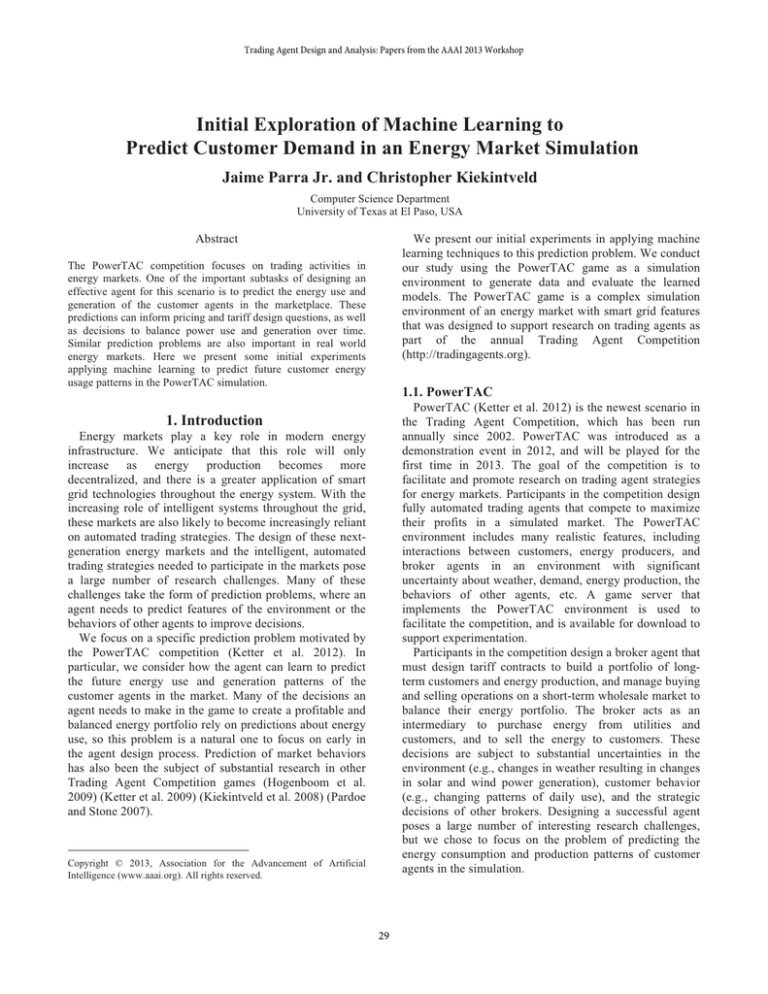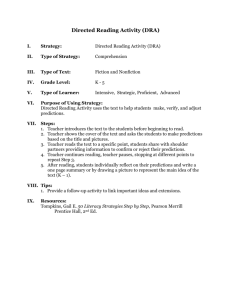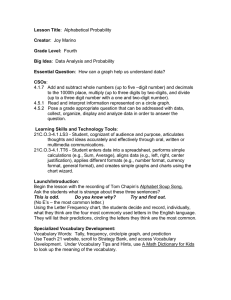
Trading Agent Design and Analysis: Papers from the AAAI 2013 Workshop
Initial Exploration of Machine Learning to
Predict Customer Demand in an Energy Market Simulation
Jaime Parra Jr. and Christopher Kiekintveld
Computer Science Department
University of Texas at El Paso, USA
Abstract
We present our initial experiments in applying machine
learning techniques to this prediction problem. We conduct
our study using the PowerTAC game as a simulation
environment to generate data and evaluate the learned
models. The PowerTAC game is a complex simulation
environment of an energy market with smart grid features
that was designed to support research on trading agents as
part of the annual Trading Agent Competition
(http://tradingagents.org).
The PowerTAC competition focuses on trading activities in
energy markets. One of the important subtasks of designing an
effective agent for this scenario is to predict the energy use and
generation of the customer agents in the marketplace. These
predictions can inform pricing and tariff design questions, as well
as decisions to balance power use and generation over time.
Similar prediction problems are also important in real world
energy markets. Here we present some initial experiments
applying machine learning to predict future customer energy
usage patterns in the PowerTAC simulation.
1.1. PowerTAC
PowerTAC (Ketter et al. 2012) is the newest scenario in
the Trading Agent Competition, which has been run
annually since 2002. PowerTAC was introduced as a
demonstration event in 2012, and will be played for the
first time in 2013. The goal of the competition is to
facilitate and promote research on trading agent strategies
for energy markets. Participants in the competition design
fully automated trading agents that compete to maximize
their profits in a simulated market. The PowerTAC
environment includes many realistic features, including
interactions between customers, energy producers, and
broker agents in an environment with significant
uncertainty about weather, demand, energy production, the
behaviors of other agents, etc. A game server that
implements the PowerTAC environment is used to
facilitate the competition, and is available for download to
support experimentation.
Participants in the competition design a broker agent that
must design tariff contracts to build a portfolio of longterm customers and energy production, and manage buying
and selling operations on a short-term wholesale market to
balance their energy portfolio. The broker acts as an
intermediary to purchase energy from utilities and
customers, and to sell the energy to customers. These
decisions are subject to substantial uncertainties in the
environment (e.g., changes in weather resulting in changes
in solar and wind power generation), customer behavior
(e.g., changing patterns of daily use), and the strategic
decisions of other brokers. Designing a successful agent
poses a large number of interesting research challenges,
but we chose to focus on the problem of predicting the
energy consumption and production patterns of customer
agents in the simulation.
1. Introductionc
Energy markets play a key role in modern energy
infrastructure. We anticipate that this role will only
increase as energy production becomes more
decentralized, and there is a greater application of smart
grid technologies throughout the energy system. With the
increasing role of intelligent systems throughout the grid,
these markets are also likely to become increasingly reliant
on automated trading strategies. The design of these nextgeneration energy markets and the intelligent, automated
trading strategies needed to participate in the markets pose
a large number of research challenges. Many of these
challenges take the form of prediction problems, where an
agent needs to predict features of the environment or the
behaviors of other agents to improve decisions.
We focus on a specific prediction problem motivated by
the PowerTAC competition (Ketter et al. 2012). In
particular, we consider how the agent can learn to predict
the future energy use and generation patterns of the
customer agents in the market. Many of the decisions an
agent needs to make in the game to create a profitable and
balanced energy portfolio rely on predictions about energy
use, so this problem is a natural one to focus on early in
the agent design process. Prediction of market behaviors
has also been the subject of substantial research in other
Trading Agent Competition games (Hogenboom et al.
2009) (Ketter et al. 2009) (Kiekintveld et al. 2008) (Pardoe
and Stone 2007).
Copyright © 2013, Association for the Advancement of Artificial
Intelligence (www.aaai.org). All rights reserved.
29
no activity, and a negative value is a customer’s energy
consumption. In the figure the main trend that can be
observed is that a customer’s usage is closely tied with the
time of the day, and that there seems to be regular cyclical
patterns that can be exploited by the learning algorithms.
The fourteen dips in the graph represent the periods with
the highest energy usage. When split up into pairs it is
easy to see that the first sink in the pair indicates the
morning when customers get ready for the day. While the
second sink occurs in the evening when there is less light.
Using this visualization tool we also identified additional
features that affected customers’ usage patterns. For
example cloud coverage appears to be an important feature
for customers that produced solar energy, while is has little
impact on a normal household consumer. After the initial
analysis, we decided to use the following features as inputs
for the learning methods:
2. Machine Learning Approach
Machine learning methods have been successfully used
in several successful agent designs for other TAC
competitions (Hogenboom et al. 2009) (Ketter et al. 2009)
(Kiekintveld et al. 2008) (Pardoe and Stone 2007). Here,
the prediction problem we address is to predict how much
energy a specific customer will use and/or generate in a
future time slot. As in the real world, customer usage is
affected by many different variables such as the weather,
time of the day, and etc. In addition, the PowerTAC
simulation implements a variety of different customer
models with different characteristics, ranging from smallscale models representing residential customers, to office
complexes and villages that aggregate large numbers of
customers in a single entity.
We attempt to learn predictive models of energy use for
each of the customer models in the game, using observable
features including historical usage patterns, the time of the
day and week, the price of energy, and weather
predictions. We make use of the Weka (Hall et al. 2009)
toolkit in our study to learn these models. Weka is a
standard open source data mining toolkit that includes
implementations of standard machine learning algorithms
and other tools aid in the initial data analysis.
We began by running approximately 30 simulations of
the game to generate a data set using default agents
provided with the game server implementation. Each game
generates a detailed log file that can be parsed to extract
information about the environment and the customer usage
patterns. We wrote code to extract all data pertaining to the
time of day (24 hours), time of the week (24 hours * 7
days = 168 hours), temperature, wind direction, wind
speed, cloud cover, a customer’s energy usage, and price
the customer was billed per energy unit. This data was then
compiled into data files for Weka to read.
•
•
•
•
•
•
•
Time of the week – This feature appears to be the
most influential for all types of customers, based
on the initial data analysis and the specification of
the customer models. We divide each week into
168 hour-long time slots, and use both the day
and the hour as features.
Previous usage – We calculate the previous
energy usage for the customer for the specific day
and time of week, and use this as a feature.
Cost of energy – This feature influences
customer energy use by increasing usage when
prices are low and decreasing usage when prices
are higher. We take the most recent price paid by
the customer as a feature.
Temperature – The temperature predictions
given in the weather reports.
Wind direction – The wind direction is also
given in the weather reports, and is most
important for customers that use wind turbines.
Wind speed – Wind speed is also given in the
weather reports, and impacts wind turbines.
Cloud cover – Also given in the weather reports,
and has an impact on customers with solar energy
production capabilities.
We experimented with several machine learning
techniques to learn models of customer usage patterns. The
first is a baseline that simply averages the previous usage
in specific time slots. We create 168 records for a single
customer covering each hour-long period for an entire
week from Sunday to Saturday. For each of these records,
we store the average usage, updating the average each time
data corresponding to a specific time slot is observed
during the game.
We also tested variations of two basic learning
algorithms from Weka: linear regression and M5P decision
trees. M5P decision trees were shown to have effective
Figure 1 is a Weka plot that shows the energy usage of
one sample customer model (BrooksideHomes) on the yaxis and the time of the week across the x-axis. One week
of data is shown in the figure. A positive energy usage
value indicates the customer’s produced energy, zero is for
30
3. Experimental Results
learning performance in previous studies on learning for
the TAC Supply Chain Management game (Kiekintveld et
al. 2008). We tested these algorithms both with and
without 10-fold cross-validation during the modeling
phase. We were also particularly interested in the impact
of the weather features on the performance of the learning
models. To test this, we created a basic model using only
the following core features: time of the day/week,
customer usage, and energy cost. Then, we created a
separate set of models using an additional set of features
related to weather predictions (temperature, wind speed,
wind direction, amount of cloud cover). Finally, a version
of k-Nearest Neighbors was tested using the full set of
features. This model includes a basic method for updating
the data online during the course of a game; our primary
goal in examining this algorithm was to see whether online
learning has the potential for significant improvements in
performance, as seen in previous TAC competitions. The
full set of algorithms included in our tests was:
• Historical timeslot average (Average)
• k-Nearest Neighbors with online updates (IBK
Online)
• Linear
regression
using
cross-validation
(LR_CV10)
• Linear regression using cross-validation and
weather (LR_CV10 w/ Weather)
• M5P decision trees (M5P)
• M5P decision trees using cross-validation
(P5P_CV10)
• M5P decision trees using cross-validation and
weather (M5P_CV10 w/ Weather)
After learning each of the models described above using
Weka based on the initial 30 games of sample data, we ran
experiments to test the performance of the models in new
games. During the simulation we made predictions using
each of the models, and generated log files to document
the performance of each model. The broker printed out the
predicted values of each model and the actual usage for
every turn. The results are shown in Figures 2 and 3. The
graphs display the percentage error of seven predictor
models (M5P, IBK Online, Average, LR_CV10,
M5P_CV10, LR_CV10 w/ Weather, and M5P_CV10 w/
Weather) for all customers that had non-zero values. Each
bar measures the mean error of the prediction model,
normalizing by the actual usage over the entire game.
Normalizing based on the mean over the entire game
avoids some issues that can arise in using a daily
percentage error metric when zero or very small values are
encountered. The error is calculated according to the
following formula:
The data is presented in two separate figures because
there are so many different customer models. Figure 2
contains the office and village type customer models,
while Figure 3 has the seven remaining models. Some
models that focus primarily on energy production are
omitted because our current broker does not aggressively
pursue these customers in the tariff market, so there is little
or no data available to evaluate the predictions the agent
makes about these models.
31
Overall, our results show that predicting the behavior of
the customer usage is a difficult problem, particularly for
the office and village customers. Even the best models still
had significant error for many of the models, though some
of the predictions for the customers in Figure 3 are quite
good. In addition, the models appear to have varying
characteristics, with some models producing more
predictable behaviors than others, and certain algorithms
performing better or worse depending on the models.
One feature of the data that is noticeable in Figure 2 is
the difference in behavior between base and controllable
versions of the village customers. The base customers have
lower amounts of error per model. This stems from the
behavior of controllable sources. The controllable sources
tend to have more erratic behavior, which makes them
more difficult to predict. However, this does not account
for the ability of the agents to control aspects of the
behavior for these models, which should make them more
predictable in practice (our agents currently does not use
this capability).
Another interesting result that is quite striking in Figure
2 is the strong performance of the IBK online method on
the village models. This method shows much lower error
than all of the others. IBK is the only model that updates
the prediction model during a game instance, and this
result provides some evidence that adaptive learning
during a game is important to improving the performance
of the predictions, especially for the village models. We
plan to explore the results further in future work by testing
more sophisticated methods for adaptive learning within a
game instance.
impact on the behavior, so it is reasonably that these may
not have much impact on the predictions.
As expected, the models learned using cross-validation
generally have lower error, in some cases substantially
lower. These models take longer to learn, but the benefit in
improved predictions is also clear.
Another question that we were interested in was the
impact of weather data on the predictions. Looking across
all of the models, we see that the prediction error for
models learned using either LR or M5P with and without
the weather features have similar error. This suggest that
for many of the customer models the weather has a
relatively small impact on the behavior, or at least the
current learning methods are not able to effectively use this
information to improve the predictions. However, we note
that some of the excluded models include the windmill and
solar energy farms that our agent does not currently pursue
in the tariff market. We would anticipate that these
customer models are much more dependent on the
weather, so we may see the benefits of including the
weather features more strongly when we are able to
analyze the data for these models.
Overall, the results show that there is promise in using
machine learning methods to predict usage, but that there
are significant challenges to doing this effectively. One of
the main issues is the variability of the customer models;
what works well for one type of customer may not work
well for others. We are continuing our work to identify
additional features that may be useful for improving the
predictions on some of the specialized models where errors
are currently high. The initial results from online learning
are also promising, so we plan to try additional methods
for online learning to improve predictions. Finally, we note
that this is not the only interesting prediction problem in
the PowerTAC game. Learning techniques could also be
useful for predicting market prices, how likely customers
are to adopt certain tariffs, and other features of the game.
4. References
M. Hall, E. Frank, G. Holmes, B. Pfarhringer, P. Reutemann, and I. H.
Witten 2009. The WEKA Data Mining Software: An Update. SIGKDD
Explorations, Volume 11:1.
F. Hogenboom, W. Ketter, J. van Dalen, U. Kaymak, J. Collins, and A.
Gupta 2009. Identifying and Predicting Economic Regimes in Supply
Chains Using Sales and Procurement Information. In Eleventh
International Conference on Electronic Commerce (ICEC 2009), pp. 19–
28, ACM.
Figure 3 has results for a smaller subset of customers,
and it is easier to compare the performance of the different
learning methods in this figure. For most of the models,
the baseline methods based on simple averaging and the
M5P method had the worst performance. However, for
some of the models all of the algorithms (including the
average) show similar errors, indicating that it may not be
possible to improve predictions much for these models by
taking into account additional features; depending on the
model, features like the weather may have a very limited
W. Ketter, J. Collins, P. Reddy, and M. de Weerdt 2012. The 2012 Power
Trading Agent Competitions, ERIM Report Series.
W. Ketter, J. Collins, M. Gini, A. Gupta, and P. Schrater 2009. Detecting
and Forecasting Economic Regimes in Multi-Agent Automated
Exchanges. Decision Support Systems, 47(4):307–318.
C. Kiekintveld, J. Miller, P.R. Jordan, L.F. Callender, and M.P. Wellman
2008. Forecasting Market Prices in a Supply Chain Game. Electronic
Commerce Research and Applications.
D. Pardoe and P. Stone 2007. Adapting Price Predictions in TAC SCM.
In AAMAS 2007 Workshop on Agent Mediated Electronic Commerce
IX.
32






